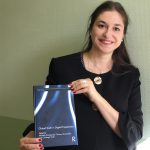What is synaesthesia?
Congenital synaesthesia or synaesthesia of natural development, as it is termed in Russian science, is a neurophysiologically determined individual trait in perceptual response that originates in early childhood. It manifests itself as individual differences in perceiving systemically organized stimuli - "categories of experience" (for example, listening to music, or perceiving and reading letters) - that are accompanied by experiencing additional sensory qualities, or concurrents, such as sensation of colors, smells, or flavors.
Congenital synaesthesia differs from coordination of the sense organs, cross-modal correspondences and intersensory associations. Unlike other perceptual effects, congenital synaesthesia is: (a) embedded in implicit systemic categorization of its inducer sets; (b) involuntary and persistent; (c) has basically non-associative representation and mentally unmotivated origin; (d) properties of concurrents or additional sensations in a different or the same sensory modality that are not directly caused by the physical qualities of the perceived reality; (e) high probability of genetic predisposition (therefore, it is termed congenital).
Synaesthesia of natural development has become an object of scientific research since the first days of psychology as a scientific discipline, at the end of the 19th century (e.g., G. Fechner, F. Galton, A. Binet). Later on, at the end of the 20th century, alongside the fast-going advancements in various areas of neuroscience, scientists’ interest in synaesthesia began to take hold with a renewed vigor. Currently, synaesthesia of natural development is being investigated in attempts to raise new questions about psychogenetic patterns, functional regularities in the human brain, propensities of natural language and metaphoric thinking and likewise of other neurocognitive conditions such as autism, mutual influence of individual differences in perception, and creative aptitudes and personality-related typological properties, to name but a few of the many focuses.
Project’s goals
The research was initiated to find the developmental specificities of congenital synaesthesia (synaesthesia of natural development) in children with a high probability of having genetic predispositions to this phenomenon (who have synaesthetic ancestors); and to reveal individual psychological (proper-cognitive, creative, personal) features concomitant with congenital synaesthesia in children and adolescents.
Incremental research objectives
- to define the main criteria for researching manifestations of congenital synaesthesia in different age groups as compared to those ones in children and adolescents;
- to adapt and modify methods and inventories for studying synaesthesia in childhood;
- to study individual differences in cognitive functions (at the level of thinking, memory and sensory mechanisms), cognitive-stylistic and perceptual-dispositional properties of cognitive activity in children and adolescents with synaesthesia;
- to research individual differences of personality-typological and temperamental (formal dynamic) properties of cognitive activity concomitant to synaesthesia of natural development, at early stages of ontogeny.
Research facilities and resources
The research project is supported by Moscow State University of Psychology and Education, with its data resources being the survey databases and the Internet platforms of the Russian synaesthesia community and the International Association of Synesthetes, Artists, and Scientists (IASAS).
Research arrangement
Stage 1 (2018-2019) - analysis and definition of the basic criteria for manifestation of synaesthesia in different age groups (including parents and children); selecting research methods; conducting research into individual psychological traits, preliminary research into individual cases of synaesthesia, as well as in a small sample (pilot study).
Stage 2 (2019) – selecting, adopting and modifying methods for studying synaesthesia and related individual psychological characteristics in childhood; researching synaesthesia and synaesthesia related individual psychological characteristics in the main sample; summing up the preliminary results of the research, processing the obtained primary data and preparing abstracts, papers and reports for conferences.
Stage 3 (2019-2020) - summing up the main results of the study, preparing a number of publications based on its results.
Study sample
The study sample includes children from 6 to 15 years old verified as or presumably having congenital synaesthesia. The assumption is based on the verified presence of synaesthesia in children themselves or their close genetic relation with their synaesthete parents.
Research methods
The standardized online test inventory “Synesthesia Battery” and the “Texsyn Toolbox” application (Russian-based version of the “Synesthesia genuineness test” by David Eagleman's laboratory);
Questionnaire “Synaesthesia Quotient” designed by A.V. Sidoroff-Dorso;
WISC (Wechsler Intelligence Scale for Children) methodology for testing children and adolescents (D. Wechsler);
Other children's (modified) methods for studying the development and functioning characteristics of memory and attention, sensory and sensory-mnemonic traits, types/styles of intelligence, thinking activity, imagination aptitudes, etc.
Research results of Stage 1
Upon completing Stage 1 of the research programme (2018-2019), the main organizational, basic methodological and research tasks of the pilot phase of the project have been implemented. To specify, the study was conducted with a small sample for the pilot stage (12 children aged 8 to 16 years; 2 males, 10 females) with close family (genetic) ties to relatives with verified synaesthesia of natural development (congenital synaesthesia in mothers), including the grapheme-color type of the phenomenon. The applied empirical methods included: the standardized online methodology “Synesthesia Battery” by D. Eagleman (Russian version: “Synesthesia genuineness test”, translation and adaptation by A.V. Sidoroff-Dorso); “Synaesthesia Quotient” inventory by A.V. Sidoroff-Dorso; WISC III (Wechsler Intelligence Scale for Children, 3d edition) methodology for testing children and adolescents (D. Wechsler). Meanwhile, it was decided to supplement the questionnaire “Synaesthesia Quotient” with instructions for parents to make administration of the tests user-friendly (observation-based survey). Additionally, the following inventories were adopted for research: "Questionnaire for identifying the features of an individual’s synaesthetic perception" (designed by A.V. Sidoroff-Dorso), free analysis of the outcomes of children’s activity (creativity) and an associative method for diagnosing personal maturity (short version). In all 12 subjects, synaesthetic reactions were verified (involuntary, consistency, constancy) according to the Synesthesia Battery, with positive results (values within the range of 0.25 to 0.91).
Comparing the biographical, typological and qualitative characteristics of synaesthesia manifestations in the research subjects such as the number and qualitative characteristics of the varieties of synaesthesia, qualitative features of concurrents, with the features of synaesthetic subjectivities as manifested in their parents, confirmed the ontogenetic, typological and qualitative similarity of manifestations of synaesthesia (homogeneity in heritability and/or the similarity of the developmental environment). The research using the WISC methodology was carried out in part, with the following scales/subtests used: Information, Comprehension, Arithmetic, Similarities, Vocabulary and Mazes. The test analysis will be provided in detail in the forthcoming publications.
Eventually, the results were used to supplement the information materials on synaesthesia in childhood and published as a booklet "Your Child, a Synaesthete" under the aegis of the Moscow State University of Psychology and Education, the Russian Society of Synaesthesia, and the International Association of Synesthetes, Artists, and Scientists (IASAS).
Research prospects
Prospects of research into congenital synaesthesia in childhood have several practical aspects. In the context of the current state of research into congenital synaesthesia (natural synaesthesia), in its social and environmental as well as general psychological perspectives, there remains a paradoxically open question about the overall prevalence of the phenomenon (4%), including a disproportionately significant number of synaesthetes in creative or artistic professions (7%). Therefore, in the field of psychological science, empirical data on the early ontogenetic periods of the development of congenital synaesthesia will inform the rationale for identifying the psychological status of this phenomenon in the structure of individuality, and, among others, as one of a systemic multi-level manifestation of predominant psychological properties, identified and intentionally developed in order to successfully implement a specific practical activity (i.e., “giftedness”), in each individual case, content-mediated depending on the varieties (types) of this phenomenon. Empirical data, including the identified propensities of cognitive, emotional-motivational and personal development, will clarify our interpretation of the mechanisms in manifestation of some genetically determined aptitudes, as well as in designing efficient methods for early development of cognitive tendencies and arranging and managing favorable conditions for fostering the corresponding abilities associated with synaesthetic features of perception.
Also, a better understanding of the status of synaesthesia among other psychological phenomena and explication of the patterns of its development in the system of individual and personal properties will make a long-sought contribution to its purposeful, introspective development (expansion, transfer, detailing) and a greater degree of involvement of synaesthetic features of perception in the cognitive sphere of synaesthetic children, including objectives of achieving practical and personally significant results.
Equally important is the body of knowledge in the science of psychology to more fully set the context for the contemporary concept of congenital synaesthesia, collecting more systematized psychological data on its emergence in childhood, which will provide meaningful content to the facts identified in laboratory conditions and testifying to the complex distributed, non-local network-like character of the associated brain structure functions of synaesthetes. The issues of the relationship between the obtained laboratory data and the results of psychological research at the moment are involved in the fact of the selective nature of the synaesthetic features of perception in some processes and operations of the cognitive activity of synaesthetes (sentient, selective induction), which needs to be explained, while the underlying systemic cognitive proper and psychological mechanisms also remain unknown. This all leaves the documented facts of the presence of synaesthetic reactions in interpretive detachment.
In addition, the relevance of the issues considered in the ongoing study are evidenced by the fact that, in a complex, general psychological understanding, knowledge about the guiding role and practical functions of congenital synaesthesia in childhood as a more explicit phenomenon can serve as a "case-model" for studying other potentially advantageous properties and qualities manifested in "fragmented" and more latent, i.e. a less accessible, forms for objective study; for example, in the form of absolute pitch, which is considered by some researchers to be a type of synaesthesia or a functionally analogous phenomenon.
The theoretical significance of the project consists in a comprehensive study of the individual psychological properties of children with synaesthesia; defining the psychological and clarifying the ontogenetic status of congenital synaesthesia on the basis of systemic ideas about the early ontogenetic manifestations of the phenomenon under study; and in substantiating the possible decisive role of natural synaesthesia in the features of the manifestation of more complex systemic and functional properties of the human psyche. Disclosure of the patterns of influence of different levels of psychological functioning associated with synaesthesia can help to identify the mechanisms of the functional connection between individual psychological characteristics (for example, in the study of other elementary and / or partial abilities, such as absolute pitch). Moreover, the disclosure of the mechanisms of synaesthesia can further shed light on the role and function of perceptual mechanisms in cognitive processes (originality, flexibility, spontaneity in the detection and solution of practical problems) and creative activity (artistic-aesthetic, value-oriented and self-realization).
The practical significance of the study lies in the possibility of applying the findings in working with children whose cognitive functions are distinguished by synaesthetic features of perception. In particular, the results obtained in the project make it possible to further develop methods for early identification of synaesthesia in order to take into account the influence of synaesthetic features on cognitive processes, the possible development of synaesthetic features, and their practical implication as an additional resource for cognition and creativity. A more complete understanding of synaesthesia from a systems point of view, the determination of its psychological status in childhood and the identification of associated psychological properties (“synaesthetic profile”) will contribute to adequate integration into the system of personal properties, the development of more complete self-understanding and harmonious self-identity of children with congenital synaesthesia. The findings of the study also represent a contribution to the clarification of the interpretation of the function of synaesthesia in the psychological aspects of the work of some prominent figures of art and science. Knowledge of the patterns of mutual influence of cognitive, cognitive and sensory mechanisms in children with synaesthesia will allow the development of individual trajectories of aesthetic development to be based on these provisions. In addition, the obtained conclusions about synaesthesia can serve as a heuristic standard for refining the models of research of other, less pronounced (i.e., more latent) phenomena in the field of the psychology of human abilities, such as early mathematical abilities and perfect pitch.
Relevant links
Research group members

N. Zakharova

S. Uzilov





